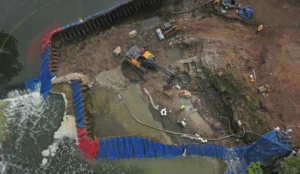Plants in and along our waterways play a crucial role in supporting the diverse ecosystem of fish and insects that live in our streams. They provide various types of habitats catering to different life stages of aquatic organisms. Whether along the shore or transitioning from dry land to underwater, these plants play an essential role in healthy water ecosystems.
Under the Water: Aquatic Plants
In the water, aquatic plants grow completely submerged or just below the water’s surface. Depth, water clarity, flow and substrate conditions determine which plants can grow in a particular body of water. For instance, some aquatic plants are more associated with rivers and streams and others with lakes or wetlands.
These underwater plants serve as important breeding grounds for fish and insects, offering safe spaces for eggs and young organisms to hide from predators. Additionally, these plants can improve a stream’s water quality by absorbing nutrients from the water and release dissolved oxygen that aquatic animals need. This is also why having a healthy plant community in your aquarium at home helps to support healthy fish.
Along the Streambank: Emergent and Riparian Zone Plants

Moving toward the water’s edge, we’ll find emergent plants that like their feet wet but extend out of the water. A few beautiful examples include Lizard’s Tail, Water Willow, and pickerelweed that grow along the edges of streams. They extend colorful blooms in the summer while their stems and roots help to stabilize soil and prevent erosion.
Stepping up a little higher, healthy native vegetation along the streambank helps to further stabilize soil. This riparian area also serves as a buffer zone that protects a stream from pollutants in stormwater runoff. Without plants, runoff would flow right into the river. With healthy riparian vegetation, the plants soak up the rainwater and reduce runoff.
The riparian area along streams also plays a critical role for the adult stages of aquatic insects (called macroinvertebrates) like dragonflies, mayflies and certain beetles. Adults lay their eggs in the water, where they hatch and spend a few weeks to several years in the water before crawling out on a stem and transforming into their adult stage. If there is good vegetation along the stream, the adults stick around to mate and lay eggs back in the same spot. Without adequate vegetation, adult insects fly elsewhere to start the cycle again. The width of the riparian area also plays a role in the diversity of insects found in the stream. In turn, the greater the diversity of insects, the greater the diversity and number of fish in the waterway.
Healthy Ecosystems Beyond the Water

Healthy, native riparian areas are not only good for the waterways and all the critters that live in them, but they also support many pollinators, birds and other wildlife. Plus, they provide beautiful places for people to connect with and enjoy our water resources. By preserving and restoring habitat in and along the stream, we ensure the well-being of our rivers and streams for generations to come.




